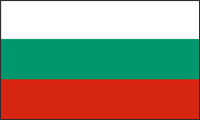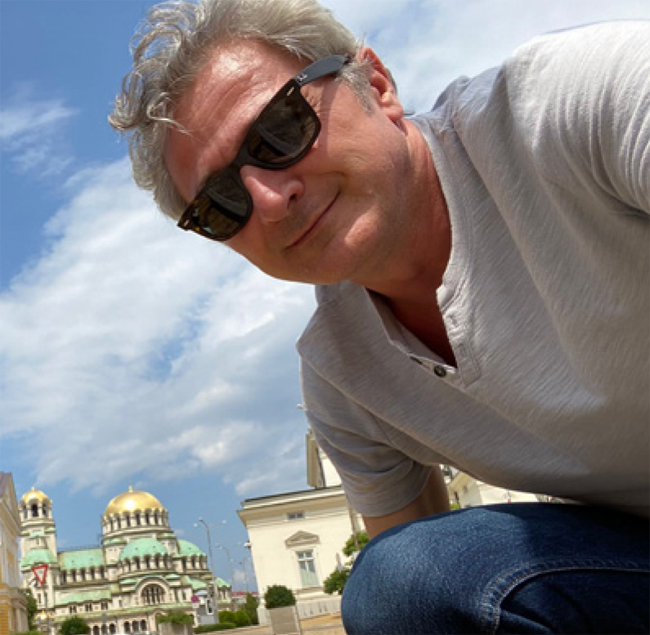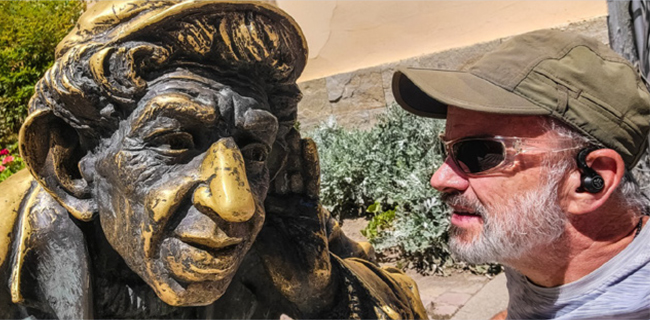By Nicola Coratella and Keith Siddel
 Nicola — an Italian living in Barcelona, he shares his non-professional energy between an insane passion for travel and a deep interest in the world of wine. Yes, many times the two go together.
Nicola — an Italian living in Barcelona, he shares his non-professional energy between an insane passion for travel and a deep interest in the world of wine. Yes, many times the two go together.
Keith — an American from Laguna Beach, is a full-time nomad since 2019, exploring the world one country at a time with a passion for diving, trekking, kiting and photography.
The following is a transcript of a phone call between Keith and Nicola, who have never met, although they were in Bulgaria at the exact same places and time in July 2021.

Sofia
Keith: Hey, Nicola! I arrived in Sofia after visiting Iraq and Afghanistan. I was looking for a modern, vibrant city with a lively cafe culture. I could relax for a few days, eat some great meals, and Sofia did not disappoint. It was my first time in Bulgaria, and I wasn’t sure what to expect, but I loved it. How was it for you?
Nicola: Well, you know it’s difficult for me to be objective about Sofia. I visited it the first time in 1989 before the “changes.” I loved it immediately as after two weeks of near hunger in Romania, a sausage rolls kiosk welcomed me just past the border. Since then, I have visited a few times, including spending some time at the university there for research.
The impression I have is that some things are changing very quickly, though others seem to stay the same over and over. Is that what makes Sofia the fascinating, lively, somehow exotic destination you think it is? What were your favorite experiences?
Keith: For me, a great city to visit is one that can be taken in at leisure, has lots of history, cultural places to visit and is easy on the wallet. I also enjoy mingling with the locals. The abundance of green spaces, outdoor cafes, and courtyard restaurants in the city center gives the city it’s dynamic feel. I am also a sucker for electric scooters. I know we are both of a distinguished age, but nevertheless, I love riding the scooters through the narrow streets, stopping to snap pictures or talking with people as I explore the city’s off-the-beaten-path alleyways. What makes Sofia memorable for you?
Nicola: Well, I won’t list all I would like to, I believe you and the TCC folks know better how to travel. A few thoughts: I loved to spend time on Vitosha boulevard. It’s commercial, busy, but it’s still a great people-watching spot! The way they have built and modernized the city around, above or in between ruins is very interesting! Oh, and “squat shops” (knee-high stores called kleks nestled in former storage cellars) are really cool. There are still a few of them around the center. The center is small, so I walked everywhere. The metro is also great. Taxis are generally and unfortunately a scam in many cases. “TaxiMe” was a great App for reliable taxi service.
Buzludzha
Nicola: Bulgaria is still shedding its Communist past, did you visit any of the old monuments?
Keith: I did visit a number of historical sites from the Communist era, both in the city and the remote areas of the country, but perhaps my favorite was the abandoned Buzludzha Monument. Located atop Bulgaria’s highest mountain, this giant UFO-looking building has all the communist hallmarks, an oversized concrete structure, and lots of symbolism. Built in 1974 to memorialize the original meeting of socialists to plan Bulgaria’s future, it is now
boarded up and decaying.

Plovdiv
Keith: I think we both visited Plovdiv. What was your impression of the city?
Nicola: I went there to watch Puccini’s Tosca performed at the Ancient Roman Theatre. Magic. The theatre is already a great sight by itself, but if you have a chance to visit during a performance, you should not miss that! You need at least a couple of days in Plovdiv. As in Sofia, you have some of the main ruins inserted in the modern center. Kind of a style on its own. Have you seen the Mevlevi monastery in the old town? It’s a mosque and a restaurant but belonged to the Order of the Whirling Dervishes. Fascinating. The rest of the old town is really remarkable as well!
Keith: I am quite jealous that you could see a performance in the outdoor theatre, those tickets are hard to get. I rented a car in Sofia for three weeks for my travels, so I was also able to get out of the city and see the other area attractions like Assen’s Fortress and the many monasteries that Bulgaria is famous for, including the Bachkovo, Transfiguration and world-famous Rila. How did you get to the city?
Nicola: I went by train from Sofia, I bought a second-class ticket for a few Euros on the way there. It was HOT; the train is not air-conditioned! I realized only after that first class was just one euro more expensive, so I decided to return to Sofia in luxury. The only difference between first and second class was that you could open the window in first class.
Bansko
Nicola: I know you visited many cities, the Black Sea and traveled across the country. Is there one place that stands out for you?
Keith: I really enjoyed the coast and exploring the ancient cities like Nessebar and Solzoplo but it was summertime and the tourists were everywhere. Bansko, several hours south of Sofia, on the other hand was quiet. Bansko is perhaps best known for its world-class skiing in the winter but those same mountains are filled with wildflowers and beautiful hiking trails in the summer. The higher altitude means that it is much cooler than in Sofia or Plovdiv. I enjoy hiking and the mountains so Bansko was a perfect base for several days of trekking, exploring the winding mountain roads and small villages and national parks. You did some exploring as well in the wine country right?
Wine Areas
Nicola: I was telling you before that one of the things evolving very quickly are Bulgarian wines. I finally had the opportunity to visit the Melnik area where some of the best wineries are located. I won’t focus on any names here, but if you’re interested please get in touch with me and I’ll share more details. It’s worth to spend a night in the Melnik village after a day of wine tasting. A great opportunity to see what rural Bulgaria looks like. All over the area you will see a lot of villages which have been basically abandoned by people, looking for better conditions in the main cities. It reminds me of some of the villages in my current host country, but with a clear communist flavor. In the Melnik village, there’s also an interesting little family winery. The wine is not great, but they are famous because the current owner (and apparently his grandfather, as well) have six fingers! Another great area for wine tasting is the Thracian Valley, near Plovdiv. Great powerful wines which are going to surprise connoisseurs and travelers. Some of them are producing wines using the system used in Italy for Amarone: they let grapes dry for months before pressing them. Really good stuff!



